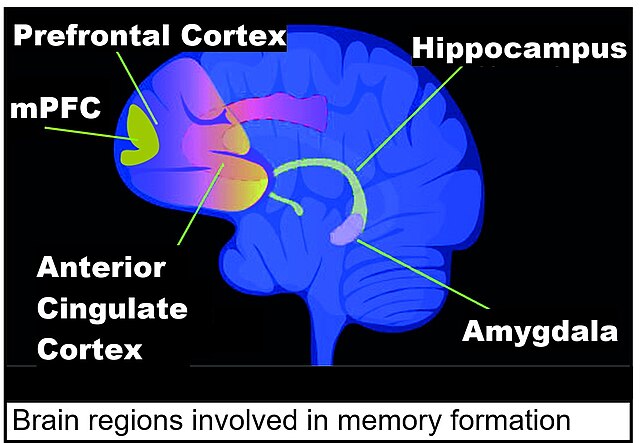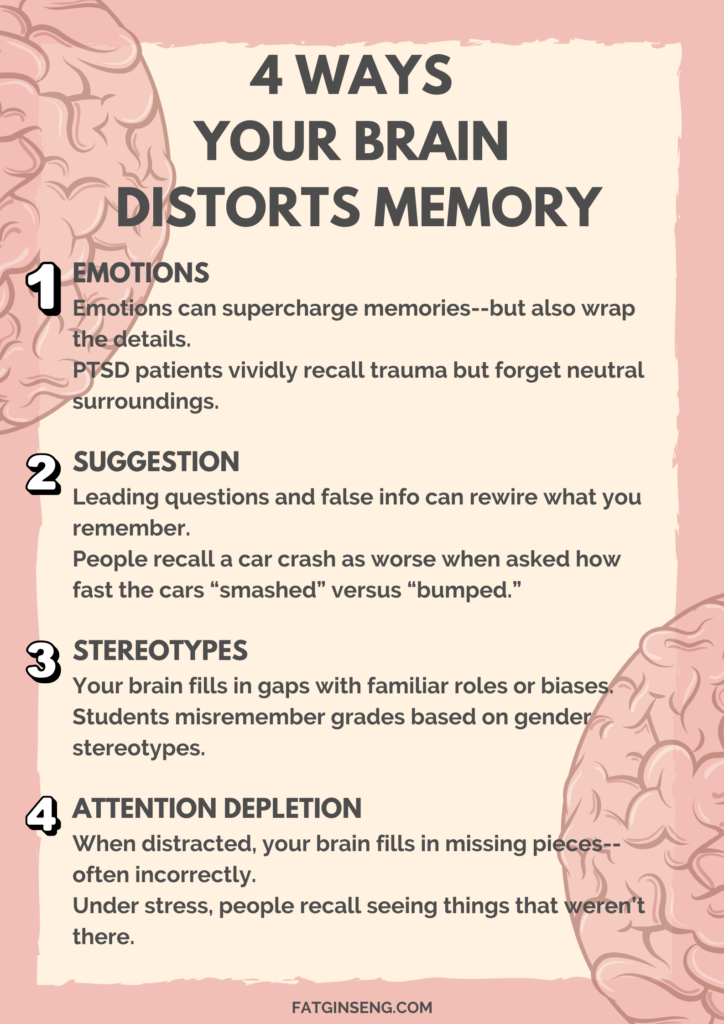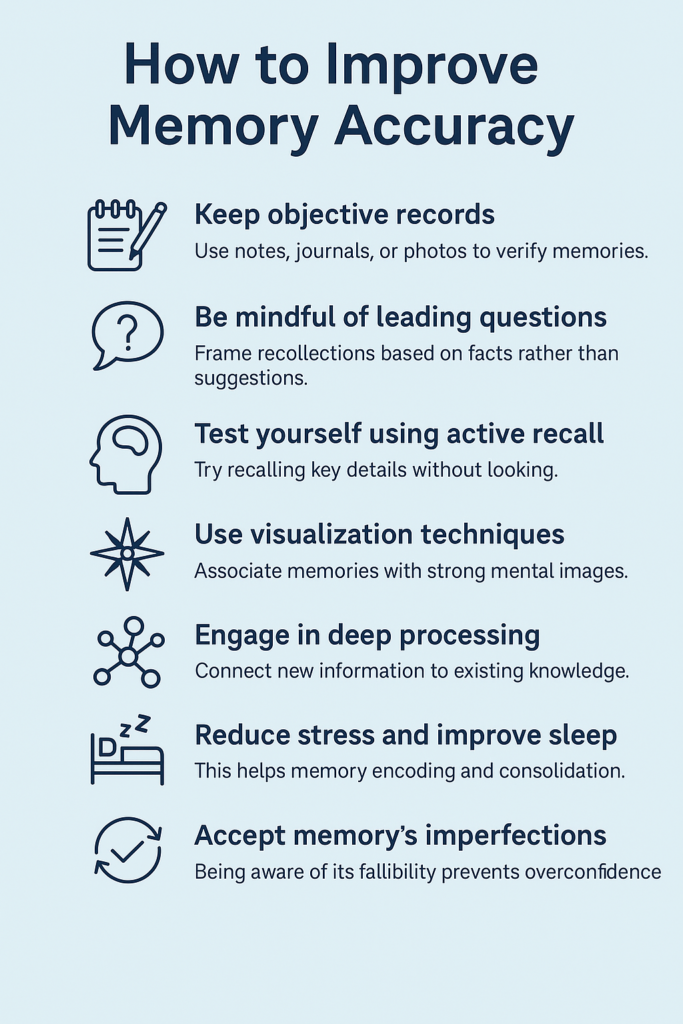
Have you ever had a heated argument with a friend or family member, only to later realize that you both remember the same event entirely differently? Maybe you swore you left your keys on the counter, only to find them in your bag. These everyday moments highlight just how unreliable memory can be.
Memory is often thought of as a perfect recording of past experiences, but in reality, it’s a reconstructive process. Rather than accurately storing events, our brains reconstruct memories using fragments of information, personal biases, and general knowledge. This means that what we remember is often shaped more by our present perspective than by the actual past.
Understanding how memory works—and where it fails—is crucial because our memories influence decision-making, personal identity, and even the legal system. This article builds upon the ideas explored in Part 1, “How Modern Life Overwhelms Your Ancient Brain,” and Part 2, “The Hidden Forces Controlling Your Decisions,” linking cognitive biases and memory fallibility to help you better navigate your thoughts and choices.
Memory Formation and Storage
📖 Learn More: Harvard University – How Memory Works | Queensland Brain Institute – Understanding Memory
How Memories Are Stored
Memory formation relies on synaptic plasticity, the brain’s ability to strengthen or weaken connections between neurons. This process is essential for learning and memory storage.
- Long-Term Potentiation (LTP): Strengthens synaptic connections between neurons, making memories more persistent.
- Long-Term Depression (LTD): Weakens less-used connections, refining the memory network.
- Neuron Ensembles: Groups of neurons activate together to encode a specific memory. These circuits make it possible to reactivate memories later.
Key Brain Regions Involved in Memory
- Hippocampus: Converts short-term memories into long-term storage.
- Amygdala: Attaches emotions, particularly fear, to memories.
- Prefrontal Cortex: Helps with working memory and long-term retrieval.
- Basal Ganglia & Cerebellum: Store motor-related memories (e.g., riding a bike).
- Neocortex: Stores long-term episodic and semantic memories.

📖 Examples:
- In “Emotions and Memory” – PTSD patients often recall traumatic events vividly but misremember small details.
- In “The Power of Suggestion” – Magicians like Derren Brown use false memory tricks to make people believe they saw something that never happened.
- In “Reconstructive vs. Reproductive Memory” – The Mandela Effect shows how many people misremember well-known details (like the Monopoly Man having a monocle—he never did!). 📖 Learn More: American Psychological Association – False Memories | Scientific American – Why Memory Fails Us

🧠 Key Takeaway: Memories are stored in circuits across the brain, not in a single location. Understanding this helps explain why memories can change over time.
Reconstructive vs. Reproductive Memory
Memory is reconstructive, meaning it actively fills in missing details based on existing knowledge and assumptions. This differs from reproductive memory, which would recall events exactly as they happened.
🔹 Example: If asked to recall your commute to work, you might remember only unique events like a roadblock while the rest is filled in based on general knowledge of your typical commute.
Factors That Influence Memory Distortion
Memory is constantly influenced by both internal and external factors. While we often trust our recollections, numerous psychological and neurological mechanisms contribute to distortions. Below are some of the most significant factors that can reshape or manipulate memory.
1️⃣ Emotions and Memory
Strong emotions play a dual role in memory formation. While emotional experiences tend to be remembered more vividly, they are also prone to distortion. Stress-related hormones like cortisol and epinephrine influence how memories are encoded and retrieved. Short bursts of stress can enhance memory, but chronic stress can weaken it.
- Fear and Trauma: High-stress situations, such as life-threatening events, strengthen memory encoding in the amygdala. However, this often comes at the expense of peripheral details.
- Mood-Congruent Memory: People are more likely to recall events that match their current mood. A person feeling sad is more likely to remember negative past events, potentially altering their perception of reality.
- Flashbulb Memories: Highly emotional or shocking events (e.g., 9/11 or personal tragedies) may feel vividly remembered, but studies show they are just as susceptible to distortion as ordinary memories.

🔹 Example: Soldiers may vividly recall life-threatening moments but misremember environmental details, such as the layout of the battlefield or what people were wearing.
2️⃣ The Power of Suggestion
Memories can be altered, fabricated, or influenced by external information, particularly through suggestive questioning or exposure to new details after an event. This phenomenon, known as the misinformation effect, occurs when people incorporate false details into their memory of an event.
- Leading Questions: The way a question is phrased can change how a person remembers an event.
- Post-Event Information: Exposure to new details (even if false) can overwrite the original memory.
- Repetition & Reinforcement: Hearing an altered version of an event multiple times can reinforce false memories, making them feel real.
🔹 Example: In one study, people who were asked, “How fast were the cars going when they smashed into each other?” recalled higher speeds than those asked, “How fast were the cars going when they bumped into each other?”
3️⃣ Stereotypes and General Knowledge
Our brains use shortcuts to categorize and recall information efficiently. However, this reliance on general knowledge and stereotypes can lead to biased or inaccurate memories.
- Stereotype-Driven Recall: When recalling an event, people may unconsciously insert details that align with societal stereotypes rather than what actually happened.
- Memory Simplification: The brain prioritizes unique details and fills in the rest using pre-existing schemas.
- Social Influence: People’s memories of an event may align with cultural norms or group opinions over time.

🔹 Example: Students recalled their grades as being higher or lower depending on their self-image, showing how personal beliefs influence memory.
4️⃣ Attentional Depletion and False Memories
When attention is divided, the brain has fewer resources to accurately encode details, making it more susceptible to false memories. Under cognitive strain, people rely more on general patterns and expectations rather than precise recollection.
- Multitasking & Memory Gaps: Engaging in multiple tasks while experiencing an event can reduce memory accuracy.
- Stress & Fatigue: High cognitive load or exhaustion can increase susceptibility to fabricated memories.
- Gist-Based Processing: Instead of recalling an event precisely, the brain reconstructs what probably happened, based on past experiences.
🔹 Example: People under cognitive load are more likely to remember stereotypical rather than factual details, such as assuming a suspect was holding a weapon in a crime they witnessed when none was actually present.

Evaluating Memory Reliability
Even though we trust our memories, research shows that confidence does not always correlate with accuracy. People are particularly prone to false confidence when relying on general knowledge instead of specific details.
🔹 Example: Studies have shown that people struggle to recall the Apple logo correctly, despite seeing it daily.
How to Improve Memory Accuracy
📖 Learn More: MIT News – Enhancing Memory Retention | Psychology Today – Tips for a Sharper Memory
✅ Keep objective records – Use notes, journals, or photos to verify memories. Writing down details soon after an event can help preserve accuracy before memory distortion occurs.
✅ Be mindful of leading questions – Frame recollections based on facts rather than suggestions. Avoid assuming details that were not explicitly experienced.
✅ Test yourself using active recall – Instead of passively reviewing notes, try recalling key details without looking. Spaced repetition, where information is reviewed at increasing intervals, strengthens long-term retention.
✅ Use visualization techniques – Associating memories with strong mental images or linking them to specific locations (the method of loci) can improve retrieval accuracy.
✅ Engage in deep processing – Connecting new information to existing knowledge, explaining it in your own words, or teaching it to someone else enhances memory retention.
✅ Reduce stress and improve sleep – Chronic stress and sleep deprivation impair memory encoding and consolidation. Prioritizing relaxation techniques and consistent sleep schedules can enhance cognitive function.
✅ Accept memory’s imperfections – Being aware of its fallibility prevents overconfidence in false details. Cross-referencing details with external sources can help verify accuracy.

Implications of Memory Fallibility
Eyewitness Testimony
📖 Learn More: The Innocence Project – The Problem with Eyewitness Testimony | National Academy of Sciences – The Science of Eyewitness Memory
Eyewitness accounts are often unreliable due to memory distortion and suggestibility. This has significant implications for the legal system, where wrongful convictions can occur based on flawed recollections.
Post-Traumatic Stress Disorder (PTSD) and Memory
Research into memory formation has led to potential treatments for PTSD. Scientists are exploring how glutamate receptors in the amygdala contribute to traumatic memories, leading to potential interventions to weaken distressing memories.
Advertising and Memory Manipulation
Advertisers exploit memory’s reconstructive nature, subtly embedding implied messages that consumers later recall as facts.
🔹 Example: A vague ad stating, “This product may help improve energy,” might be remembered later as, “This product will boost energy.”
Social and Cultural Memory
Societal narratives influence how historical events are remembered and interpreted, shaping collective memory and identity.
Final Thoughts
Memory is an incredible yet flawed process. While it shapes how we perceive reality, it is not a perfect reflection of past events. Understanding its limitations helps us make better decisions, navigate relationships with greater awareness, and prevent cognitive distortions from influencing our lives.
🔗 Related Articles:
- Part 1: How Modern Life Overwhelms Your Ancient Brain – Understanding how evolution shaped our thinking.
- Part 2: The Hidden Forces Controlling Your Decisions – Exploring cognitive biases and their impact on choices.
In the next article, we’ll explore how forgetting is just as important as remembering—and why your brain sometimes lets go of memories on purpose. Stay tuned!
🔔 Follow Fat Ginseng for more insights on psychology, human behavior, and self-improvement!


